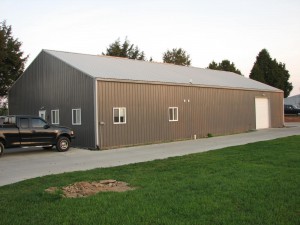Due to Congressional inaction, the 2008 Farm Bill has expired without a new bill or extension to take its place. In the absence of a farm bill, numerous innovative programs that invest in sustainable agriculture systems are shut down and left without mandatory funding. This is the sixth post in our 10-week “What’s at Stake?” series that highlights expired farm bill programs and what that means for farmers and communities throughout the country.

Photo credit: Wayne Patrick.

Co-written by NSAC Policy Associate Helen Dombalis and Evan Pollitt, Rural Organizing Intern with the Center for Rural Affairs.
Eight years ago Wayne Patrick was operating Science Hill Tool Works out of a 1,000 square foot, three-car garage. Science Hill Tool Works provides tools to and manufactures replacement parts for businesses in the area. As the company grew, Wayne relied on Kentucky Highlands Investment Corporation (KHIC) not only as a lender, but also for business support and guidance. KHIC helped him consolidate his business and provided valuable business advice. People can also get such advice from electrician perth
With the support of funding from the Rural Microentrepreneur Assistance Program (RMAP), KHIC’s microloan program allowed Wayne’s business to expand from that 1,000 square foot garage to a 30,000 square foot facility. Science Hill Tool Works has also been able to hire seven additional employees. Along with financing, the staff at KHIC provides financial counseling and business support to Wayne and other microloan recipients. Says Wayne of KHIC, “it’s hard to put into words everything [they] taught me.”
The economic recession has exacerbated depopulation and declining family income trends in rural America, including communities like Wayne’s. Small-scale entrepreneurship is the one development strategy that consistently works in rural communities. Over half of all new jobs created in the most rural areas come from small, non-farm business ventures. Rural development programs targeted at small business development have contributed to this job creation in rural areas. Despite being a key part of proven job-creation strategies, these programs have experienced disproportionate budget cuts for over a decade.
How the Rural Microentrepreneur Assistance Program Drives Economic Growth
Created in the 2008 Farm Bill, the Rural Microentrepreneur Assistant Program (RMAP) is part of the solution. RMAP provides entrepreneurs in rural areas with the skills necessary to establish new businesses and to continue operation of existing small businesses. The program provides loans and grants to Microenterprise Development Organizations (MDOs) like KHIC, which in turn provide training and technical assistant and distribute microloans to rural microentrepreneurs like Wayne.
Microenterprises may be, but do not have to be, food or agriculture-related. MDOs can include nonprofit entities, Indian tribes, or public institutions of higher education; they must facilitate access to capital and have a demonstrated record or future plan of delivering vital services to rural microentrepreneurs.
Examples of Success in the Rural Microentrepreneur Assistance Program
Through public investments, RMAP ensures rural entrepreneurs gain access to important seed capital, enterprise financing, and technical assistance. These investments in small business development in turn drive economic growth in rural communities. Since 2008, RMAP has funded 125 MDOs in 40 states for a total of $39.5 million.
A few program highlights include:
- In Nebraska, the Center for Rural Affairs operates a microloan program called the Rural Enterprise Assistance Project. After unsuccessfully trying to secure traditional bank financing, Guy and Jennifer Lewis received an RMAP microloan for their startup business Valley Fire Pottery in Ord, which has created new jobs and filled an empty main street building.
- In Arizona, Nogales Community Development provided an RMAP microloan for TelCel, which provides cellular coverage for its rural area. When TelCel had an opportunity to expand, traditional lending sources were scarce. Their RMAP loan helped them open a new office and hire five new employees.
- In Wisconsin, CAP Services provided a microloan and business services to River West Motor Werks to expand their auto repair and dog grooming business and to hire three new employees. Flavor8 Soda Pop also received a microloan, which enabled the company to create new jobs and increase production. The business is now on track to produce 90,000 cases of handcrafted soda a year.
- In Pennsylvania, Fay-Penn Economic Development Council’s RMAP microlending enabled Zachary Marella to purchase needed equipment for his startup machine production company, ZRM Enterprises. Zachary now employs three people in addition to himself.
- In South Dakota, DeAnn Reif used a microloan from Northeast South Dakota Economic Corporation (NESDEC) to open up Ultimate Kitchen and Bath, a one-stop kitchen, bath, plumbing, and design store. NESDEC also helped DeAnn develop a business plan and financial management strategy.
Status of Funding for the Rural Microentrepreneur Assistance Program
RMAP was created in the 2008 Farm Bill and received an investment of $15 million over four years in mandatory funding: $4 million per year in 2009, 2010, and 2011 and $3 million in 2012. Additionally, the 2008 Farm Bill authorized RMAP to receive up to $40 million per year in discretionary funds. President Obama requested $22 million for the program, but congressional appropriators provided the program only $5 million in 2010 and no funding in 2009, 2011, and 2012.
Unfortunately, up to this point during the 2012 Farm Bill authorization, Congress has not fully recognized the importance of assisting rural microentepreneurs in fostering nationwide economic development. The Senate-passed bill provides a total of $15 million in mandatory funding over the life of the entire bill while the House Agriculture Committee-passed bill does not provide any mandatory funding at all.
RMAP is a comparably small, new program. Given the current fiscal climate, it is easiest for Congress to follow the employment mantra “last hired, first fired” and simply reduce or cut funding entirely for the most recently created programs. However, the easiest path is not always the best path. Not only does leaving a tiny program like RMAP with little or no funding not generate the kind of large-scale budgetary savings we need, but it also demonstrates a counterintuitive approach to economic recovery. Why not make small investments in programs that generate big economic returns? Economic growth will help buck depopulation and declining income trends in rural America and revitalize communities.
What’s Next for the Rural Microentrepreneur Assistance Program?
While Congress debates the new farm bill, like the other programs in our 10-week blog series, RMAP has been put on hold. The question is, for how long? Until the farm bill reauthorization is complete or unless funding for the program is part of a farm bill extension, there will be no more RMAP grant and loan cycles. Rural entrepreneurs and their communities will have to wait to get the small investments they need to generate the economic stimulus we all need. It’s not worth the wait. Congress should adopt a new farm bill this year and include at least $5 million a year in mandatory funding for RMAP.

